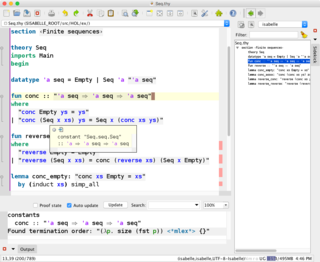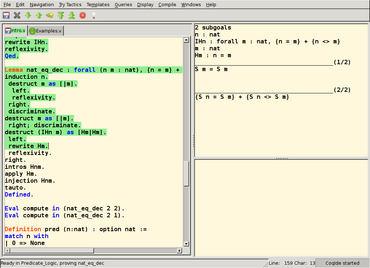Automated theorem proving is a subfield of automated reasoning and mathematical logic dealing with proving mathematical theorems by computer programs. Automated reasoning over mathematical proof was a major impetus for the development of computer science.

The Isabelle automated theorem prover is a higher-order logic (HOL) theorem prover, written in Standard ML and Scala. As an LCF-style theorem prover, it is based on a small logical core (kernel) to increase the trustworthiness of proofs without requiring — yet supporting — explicit proof objects.
HOL denotes a family of interactive theorem proving systems using similar (higher-order) logics and implementation strategies. Systems in this family follow the LCF approach as they are implemented as a library which defines an abstract data type of proven theorems such that new objects of this type can only be created using the functions in the library which correspond to inference rules in higher-order logic. As long as these functions are correctly implemented, all theorems proven in the system must be valid. As such, a large system can be built on top of a small trusted kernel.
Logic for Computable Functions (LCF) is an interactive automated theorem prover developed at Stanford and Edinburgh by Robin Milner and collaborators in early 1970s, based on the theoretical foundation of logic of computable functions previously proposed by Dana Scott. Work on the LCF system introduced the general-purpose programming language ML to allow users to write theorem-proving tactics, supporting algebraic data types, parametric polymorphism, abstract data types, and exceptions.

The Mizar system consists of a formal language for writing mathematical definitions and proofs, a proof assistant, which is able to mechanically check proofs written in this language, and a library of formalized mathematics, which can be used in the proof of new theorems. The system is maintained and developed by the Mizar Project, formerly under the direction of its founder Andrzej Trybulec.
The QED manifesto was a proposal for a computer-based database of all mathematical knowledge, strictly formalized and with all proofs having been checked automatically.

Coq is an interactive theorem prover first released in 1989. It allows for expressing mathematical assertions, mechanically checks proofs of these assertions, helps find formal proofs, and extracts a certified program from the constructive proof of its formal specification. Coq works within the theory of the calculus of inductive constructions, a derivative of the calculus of constructions. Coq is not an automated theorem prover but includes automatic theorem proving tactics (procedures) and various decision procedures.
In logic, a logical framework provides a means to define a logic as a signature in a higher-order type theory in such a way that provability of a formula in the original logic reduces to a type inhabitation problem in the framework type theory. This approach has been used successfully for (interactive) automated theorem proving. The first logical framework was Automath; however, the name of the idea comes from the more widely known Edinburgh Logical Framework, LF. Several more recent proof tools like Isabelle are based on this idea. Unlike a direct embedding, the logical framework approach allows many logics to be embedded in the same type system.
Twelf is an implementation of the logical framework LF developed by Frank Pfenning and Carsten Schürmann at Carnegie Mellon University. It is used for logic programming and for the formalization of programming language theory.
A computer-assisted proof is a mathematical proof that has been at least partially generated by computer.
In computer science, in particular in knowledge representation and reasoning and metalogic, the area of automated reasoning is dedicated to understanding different aspects of reasoning. The study of automated reasoning helps produce computer programs that allow computers to reason completely, or nearly completely, automatically. Although automated reasoning is considered a sub-field of artificial intelligence, it also has connections with theoretical computer science and philosophy.

Peter Bruce Andrews (born 1937) is an American mathematician and Professor of Mathematics, Emeritus at Carnegie Mellon University in Pittsburgh, Pennsylvania, and the creator of the mathematical logic Q0. He received his Ph.D. from Princeton University in 1964 under the tutelage of Alonzo Church. He received the Herbrand Award in 2003. His research group designed the TPS automated theorem prover. A subsystem ETPS (Educational Theorem Proving System) of TPS is used to help students learn logic by interactively constructing natural deduction proofs.
HOL Light is a proof assistant for classical higher-order logic. It is a member of the HOL theorem prover family. Compared with other HOL systems, HOL Light is intended to have relatively simple foundations. HOL Light is authored and maintained by the mathematician and computer scientist John Harrison. HOL Light is released under the simplified BSD license.
Metamath is a formal language and an associated computer program for archiving and verifying mathematical proofs. Several databases of proved theorems have been developed using Metamath covering standard results in logic, set theory, number theory, algebra, topology and analysis, among others.
Automath is a formal language, devised by Nicolaas Govert de Bruijn starting in 1967, for expressing complete mathematical theories in such a way that an included automated proof checker can verify their correctness.
In mathematical logic, a judgment or assertion is a statement or enunciation in a metalanguage. For example, typical judgments in first-order logic would be that a string is a well-formed formula, or that a proposition is true. Similarly, a judgment may assert the occurrence of a free variable in an expression of the object language, or the provability of a proposition. In general, a judgment may be any inductively definable assertion in the metatheory.
Interactive Theorem Proving (ITP) is an annual international academic conference on the topic of automated theorem proving, proof assistants and related topics, ranging from theoretical foundations to implementation aspects and applications in program verification, security, and formalization of mathematics.

Grigore Roșu is a computer science professor at the University of Illinois at Urbana-Champaign and a researcher in the Information Trust Institute. He is known for his contributions in runtime verification, the K framework, matching logic, and automated coinduction.
Dale Miller is an American computer scientist and author. He is a Director of Research at Inria Saclay and one of the designers of the λProlog programming language and the Abella interactive theorem prover.






